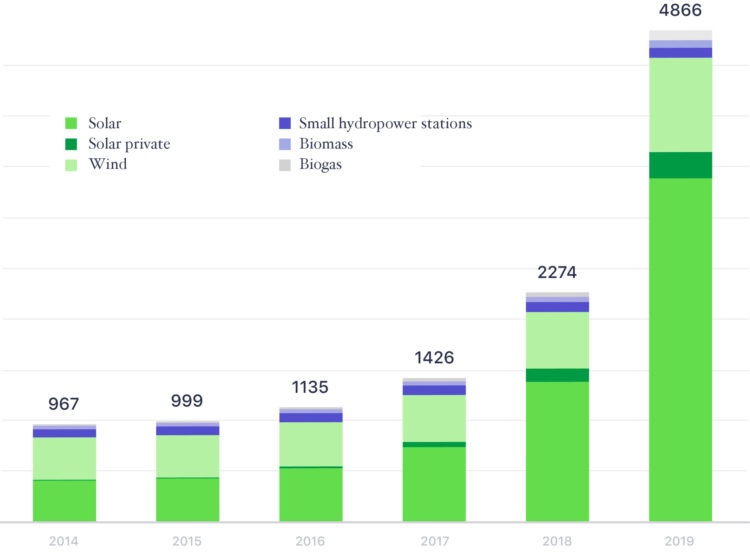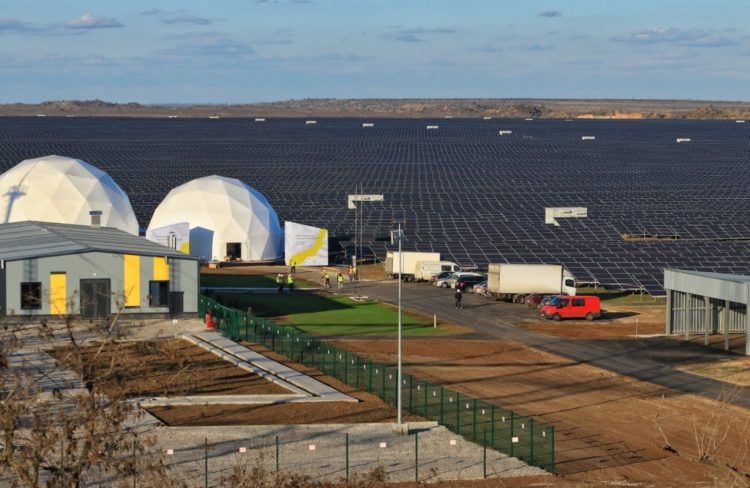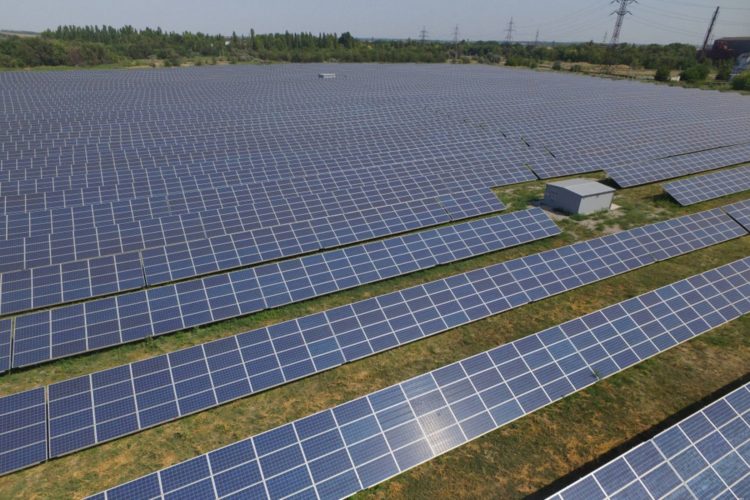Ukraine's green revolution has all chances to keep making progress -- if Ukraine's leaders find it in themselves to carry out their promises and not give in to populist rhetoric.
Ukraine is commonly referred to as one of the world’s leading agricultural producers, notably the second-largest exporter of grain, after the USA. Also, the country has the largest and fastest-growing IT sector in Europe. Today, Ukraine employs about 105,000 IT developers, most of whom are based in Kyiv, Kharkiv, and Lviv.
Since 2019, renewable energy can be added to the list of Ukraine’s economic successes. Between 2015 and 2020, the overall capacity of solar power plants in Ukraine grew 12 times, while that of wind power plants tripled. Also, an entirely new sector of small private houses as solar power plants emerged.
The EU is currently the world’s leading region in renewables.

Renewables entered the top five sectors by direct foreign investments in Ukraine. In 2020, the country was ranked 14 out of 108 developing countries worldwide by the attractiveness for investment in the renewable energy sector (Climatescope rating by Bloomberg New Energy Finance, 2020). The fall from ninth position in 2019 to fourteenth in 2020 was caused by budget shortages due to the coronavirus crisis and subsequent state debts to the producers of renewable energy.
Euromaidan Press talked with Ukrainian solar energy producers to understand how Ukraine can overcome the current crisis and whether renewables can continue their rapid growth, not only boosting the country’s economy but also giving Ukraine an entrance ticket to join the world’s most climate-neutral states.
Green tariffs, rapid growth, and socialist manipulation

From the fall of the USSR in 1991 until 2015, Ukraine did not build a single new big power plant, whether state or private-constructed. The old coal and nuclear power plants had become outdated, with the need for their inevitable replacement emerging into view.
Things changed after 2015, when the new “green tariffs,” commonly referred to as feed-in tariffs, were effectively introduced by the Ukrainian government to boost the market of renewable energy production.
In Ukraine, the first law on green tariffs was adopted back in 2008, although only effectively introduced in 2015. Manufacturers can use the green tariff for 10 years after installing a power plant. It is roughly twice as high as the market price of electricity, although there are differences between the types of electricity production. Additionally, the green tariff in Ukraine was bound to the EUR/UAH currency exchange rate so as to mitigate risks for foreign investors.
Being among the highest green tariffs in Europe, it facilitated direct foreign investments into renewables in Ukraine.

Andriy Zinchenko, head at the solar energy cooperative Solar City, told us that although Ukrainian consumers spend additional money to cover the green tariff, it does pay off.
First, new power plants, which Ukraine could not have managed without capital investment, are built. This prevents potential energy collapse.
Second, direct foreign investments create additional jobs, mitigate currency devaluation, with all this creating additional tax income for the state. Overall, more than $10 billion has been invested in renewable energy in Ukraine since 2015, with almost $4 bn in 2019 alone.
“Manipulative socialist conversations take place, [alleging that the green tariff is too high and takes away money from Ukraine to investors]. In fact, no generating capacity has been built in Ukraine since independence except for renewable energy sources… The only serious capital investments in energy are renewable energy sources. Second, if we talk about the green tariff and its economic parameters, in all countries, including in Germany, it was used to launch a market, to create a certain volume of market, and then move on to other forms of support. First, the feed-in tariff; then the so-called feed-in premium, for example, through auctions. If you look at Germany, green tariffs are also higher there than the market prices… In Ukraine, it should be even higher, considering that we are a risky country. If there were no significantly higher prices, investors would not be interested in coming,” Zinchenko told.
A related problem is left-wing populism in Ukraine, when authorities speculate on lowering consumption tariffs for households, creating additional burdens for the state, and then claim that renewable energy companies are “guilty” for taking additional money through green tariffs. Even though these are the only companies who build new power plants and save Ukrainian energy sector from a collapse:
“Well, and last but not least, the state and the energy market are quite different things,” says Zinchenko. “Everything in the energy market is always paid for with consumer money, including the need to build new power plants in place of the Soviet ones that never came out of the 20th century. The only problem is that in the rush to fight with ‘the high green tariffs,’ a provision was introduced in the latest legislation, according to which 20% of green tariffs are to be reimbursed from the state budget. The talk that the green tariff is not profitable for the state is conducted by the very same people who submitted this amendment. It does not seem logical.”
The populist talk against high prices for renewable energy intensified after the government reshuffle in March 2020, when Denys Shmyhal’s government took over. New Prime Minister Shmyhal was known as a top manager in oligarch Rinat Akhmetov’s electricity and energy company DTEK — the main owner of Ukrainian coal power plants.
Not surprisingly, the new prime minister started a rather unfavorable policy towards renewables.
Shmyhal and Zelenskyy taken hostage by own populist rhetoric
Almost immediately after the government reshuffle, supported by Zelenskyy and approved by the parliament, payments to the producers of renewable energy stopped, allegedly due to lack of money to pay the green tariff. Subsequently, in August 2020 the government signed a Memorandum with the two associations of renewable energy producers.
The memorandum envisaged debt restructuring and the lowering of the green tariff with its prolongation in time. A first glance, quite a fair decision based on mutual understanding. However, not all producers of renewable energy were members of these associations, and not all signed the memorandum. Subsequently, those who disagreed were simply ignored by the government.
“When the state retroactively changes the terms of the contract, it is generally called a robbery,” commented Zinchenko, predicting court appeals against the state. “If some companies go to court, they have very good chances of winning. The position of the state is quite shaky.”
The general provisions of the memorandum were that the state pay 40% of the 2020 debt immediately and the remaining 60% during 2021. As Zinchenko admits from his company’s experience, the new payments in 2021 are being delivered regularly and honestly, However, the 2020 debt has still not been paid in full. It is hard to predict whether the government will pay all debts in 2021, as it initially promised, especially considering the new decisions to issue state obligations that are supposed to cover this debt but only in 2022.
Although the government has renewed all new payments, the 2020 crisis, debt, and change of rules without agreement with all companies has undermined trust amongst the investors. The only way out is to pay debts as soon as possible and maintain all regular payments according to the green tariff.
Naturally, [highlight]such a policy may require the rise of consumer prices for electricity – a logical policy taking into account the poor state of Ukraine’s old power plants and the need for new ones. However, Shmyhal and Zelenskyy have become hostages of their own populist rhetoric.[/highlight]
The myth about poor “ordinary Ukrainians”
A bright example of populist statements regarding renewable energy is that green tariffs allegedly feed foreign investors and Ukrainian oligarchs who also build solar power plants. And “ordinary Ukrainians” have to pay. In fact, the opposite is true.
The state is spending huge subsidies on old nuclear and coal power plants controlled by few oligarchs. And the market of renewables is a way out of this. Even if some oligarchs participate in this new market, they are just minor players along with hundreds of others. The market of renewables, therefore, is also the way out of corruption schemes, Andriy Zinchenko confirms:
“How many companies can you count in the energy market that we inherited from the USSR? At the same time, the sector of renewable energy is very diverse. There are hundreds of companies that range in size – from huge internationals such as Norwegian Scatec to small companies. It is a manipulation to say that Akhmetov controls the renewable energy market and earns on green tariffs, as some politicians say. He controls less than 20%, the numbers do not match."
“The largest solar power plant in Europe” and other bright examples to be maintained and developed
Indeed, there are Norwegian, German, French, and also Chinese companies that operate in the Ukrainian renewable energy market, as well as many Ukrainian domestic companies. The bright examples of rapid development include both care about the environment and the capacity and economic impact of new power facilities. Both things are important and should be further developed by wise governmental policy.
Compliance. For example, the Norwegian Scatec Solar operating in Ukraine has probably the highest ecological and social standards among the companies in the country. As the communication manager of the company Tetiana Voytovych told us, the company directs part of its profits for the implementation of local projects in the villages where their power plants are located. Locals themselves propose and vote for the project while the company funds them. Also, the company conducts a careful analysis of the ecological impact of their power plants. When rare species of moles were detected in the place where a power plant was planned, the company hired specialists to investigate the impact on the moles and subsequently moved the power plant to another place.
Energy cooperatives. Also, there are domestic Ukrainian companies using solar energy to provide investment opportunities for ordinary Ukrainians. The Solar City became the first huge Ukrainian energy cooperative of 97 small investors and plans to expand further. For now, 720 solar panels were installed on roofs in the small Ukrainian town of Slavutych:
https://www.facebook.com/sun.city.slavutych/posts/883267328850318?__cft__[0]=AZVGcuCmQT8ApGBryd_K7Fj8l8lmY9b5vDtc7zs34SIxXNNhJRu65i6Af8O6QAkZDXf7Sjp2v66Xck-H979GoR_gBgHwQRYcNqN1B3j4Eag_zEadAmHyDv2jRwS9yssmkZvJofK-bkYDVe4vDzwVv6oGag3gwoRYA2r2umLTVLVCzQ&__tn__=%2CO%2CP-R
Individual micro power plants.
What is yet more impressive is many Ukrainianі installing individual mini-solar power plants on their roofs. They consume their own energy and the surplus is sold into networks by the green tariffs.
The increase in domestic power plants was tremendous, from just 21 examples in 2014 to 14,790 by the end of 2020:

Huge players. Finally, important are huge power plants that can greatly decarbonize energy production. Large Chinese and Ukrainian investors are leading in this area.
In 2019, the large Pokrovsk 400 megawatt power plant started working in the Dnipro Oblast in Ukraine, steadily reaching its full capacity. The media reported about “the biggest power plant in Europe.” It is in fact one of the biggest, being comparable to such giants as the Núñez de Balboa 500 megawatt power plant in Spain or 300-megawatt Cestas Solar Park in France. Overall, 840,000 solar panels were installed on 437 hectares of land in Pokrovsk. Located on the territory of an old mine, this power plant can supply electricity to about 200,000 households.

Meanwhile, a wind plant that is among the most powerful plants in Europe is planned in the Zaporizhzhia Oblast. An agreement on joint construction was signed by the Norwegian company NBT AS and China Electric Power Equipment and Technology. The contract provides for the construction of two wind power plants with a total capacity of 750 megawatts.
Further prospects of decarbonization and development
Overall, the EU has a goal to become carbon neutral by 2050. Germany, for example, plans to increase the share of renewable energy production to 65% by 2035, while leaders Iceland and Norway have already reached this target.
In the Ukrainian strategy, 25% was envisaged by 2035. However, the country has the potential to reach this goal much more quickly, having already attained 11%. All depends on the ability of the government to refrain from populism and properly pay the 2020 debts, as well as raise the electricity price to the market level. The latter was successfully done with gas prices and proved its effectiveness. This move will provide enough money to pay according to the green tariff. No additional spending will be required from the state budget.
Potentially, renewable energy can become one of the pillars of the revitalized Ukrainian economy. Renewable energy currently comprises almost 2% of tax income to the state budget – UAH 67 bn ($2.4 bn) over the last four years. And this figure can be significantly increased.
In April 2019, the Verkhovna Rada supported bill № 8449-d, which introduces a new system of auctions in renewable energy. According to the law, the starting price is the size of the "green tariff" defined in the law. The winner of the auction will be the one who offers the lowest selling price of 1 kilowatt-hour. The first auctions are expected this year, opening a new era in the Ukrainian renewable energy market.
The other important novelty is the planned introduction of open competition to build and maintain new networks and facilities which should save and level the energy coming from the new power plants.
Yet once again all this requires proper policy from the government and all treaties being left unviolated. While the state does not have free money and state debt is already high, hikes in electricity prices are the only effective way out of the crisis. It can renew Ukrainian energy facilities, in line with ecological and safety rules, as well as boost the economy.
This publication is part of the Ukraine Explained series, which is aimed at telling the truth about Ukraine’s successes to the world. It is produced with the support of the National Democratic Institute in cooperation with the Ukrainian Crisis Media Center, Internews, StopFake, and Texty.org.ua. Content is produced independently of the NDI and may or may not reflect the position of the Institute. Learn more about the project here.





